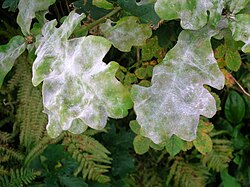| Erysiphe | |
|---|---|
 | |
| An Erysiphe species on a Quercus leaf. | |
| Scientific classification | |
| Kingdom: | Fungi |
| Division: | Ascomycota |
| Class: | Leotiomycetes |
| Order: | Helotiales |
| Family: | Erysiphaceae |
| Genus: | Erysiphe R.Hedw. ex DC., 1805 |
| Type species | |
| Erysiphe polygoni DC., 1805 | |
| Synonyms | |
| |
Erysiphe is a genus of plant pathogenic fungi in the family Erysiphaceae. [1] The species in this genus are known for causing powdery mildew.